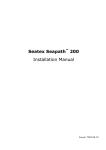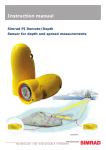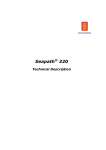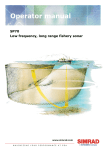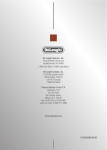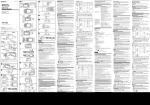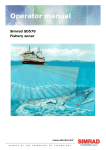Download Simrad SH90 - PRODUCT DESCRIPTION REV A Specifications
Transcript
Simrad SH90 Product description This document provides a general description of the Simrad SH90 Fish finding sonar. It also provides presentation examples, the technical specifications, and the outline dimension drawings required for installation. 337405/A 03.09.2009 History Document no: 337405 / Version: A Rev.A 03.09.2009 Original release. Copyright ©2009 Kongsberg Maritime AS The information contained in this document remains the sole property of Kongsberg Maritime AS. No part of this document may be copied or reproduced in any form or by any means, and the information contained within it is not to be communicated to a third party, without the prior written consent of Kongsberg Maritime AS. The document, or any part of it, may not be translated to any other language without the written approval from Kongsberg Maritime AS. Disclaimer Kongsberg Maritime AS endeavours to ensure that all information in this document is correct and fairly stated, but does not accept liability for any errors or omissions. Warning The equipment to which this manual applies must only be used for the purpose for which it was designed. Improper use or maintenance may cause damage to the equipment and/or injury to personnel. The user must be familiar with the contents of the appropriate manuals before attempting to install, operate or work on the equipment. Kongsberg Maritime AS disclaims any responsibility for damage or injury caused by improper installation, use or maintenance of the equipment. Support If you require maintenance on your Fish finding sonar system contact your local dealer. You can also contact us using the following address: -. If you need information about our other products, visit our web site. On the web site you will also find a list of our dealers and distributors. S im r a d Ko n g s b e r g M a r it im e A S S t ra n d p rom e n a d e n 5 0 P. O. Bo x 1 1 1 N- 3 1 9 1 H o r t e n , N o r w a y Te le p h o n e : + 4 7 3 3 0 3 4 0 0 0 Te le fa x : + 4 7 3 3 0 4 2 9 8 7 w w w . s im r a d . c o m c o n t a c t @ s im r a d . c o m Product description Table of contents SIMRAD SH90 ................................................................... 5 Basic information .....................................................................................................5 Main units.................................................................................................................5 Wheelhouse units.......................................................................................... 6 Sonar room units........................................................................................... 7 System diagram ........................................................................................................8 Basic functionality....................................................................................................9 Omni beam................................................................................................... 9 Stabilisation system .................................................................................... 10 Reception ................................................................................................... 11 Transmission .............................................................................................. 12 MENU SYSTEM ................................................................ 14 OPERATING PANEL ......................................................... 15 EXAMPLES ...................................................................... 16 TECHNICAL SPECIFICATIONS ......................................... 18 Power specifications ...............................................................................................18 Weights and outline dimensions.............................................................................19 Environmental specifications .................................................................................21 Performance specifications.....................................................................................22 DRAWING FILE ............................................................... 24 Transceiver Unit dimensions ..................................................................................25 Forward view ............................................................................................. 25 Side view ................................................................................................... 26 Top view .................................................................................................... 27 Power Supply Unit dimensions ..............................................................................28 Forward view ............................................................................................. 28 Side view ................................................................................................... 29 Processor Unit dimensions .....................................................................................30 Forward view ............................................................................................. 30 Side view ................................................................................................... 31 Footprint .................................................................................................... 32 Operating Panel dimensions ...................................................................................33 SH90 Hull unit dimensions ....................................................................................34 SH90 Sonar trunk dimensions ................................................................................35 SH90 Sonar trunk production.................................................................................36 Side view ................................................................................................... 36 Top view .................................................................................................... 37 337405/A 3 Simrad SH90 SH90 Blind cover dimensions ................................................................................38 COMPANY PROFILE ......................................................... 39 Simrad ....................................................................................................................39 Kongsberg Maritime AS.........................................................................................39 Kongsberg Group ...................................................................................................41 4 337405/A Simrad SH90 SIMRAD SH90 Study this chapter to familiarize yourself with the Simrad SH90 Fish finding sonar system. Topics • Basic information on page 5 • Main units on page 5 • System diagram on page 8 • Basic functionality on page 9 Basic information The Simrad SH90 is an omnidirectional high frequency sonar. It is designed for all sized fishing vessels, both purse seiners and trawlers. The operational frequency is 114 kHz. The cylindrical multi-element transducer allows the omnidirectional sonar beam to be tilted electronically from +10 to –60 degrees. This allows you to automatically track schools of fish, and to observe the whole water volume around the vessel. A stabilising system is included for electronic pitch and roll compensation. Great emphasis has been placed on giving the best possible presentations on a high resolution colour display. The Processor Unit is controlled by Microsoft’s Windows XP® operating system, which result in a flexible choice of display modes for a large range of user applications. The signal processing and beamforming is performed in a fast digital signal processing system using the full dynamic range of the signals. In addition to the traditional single frequency transceiver system, the Simrad SH90 contains an advanced frequency modulated filter system (FM). Main units The Simrad SH90 comprises the following main units: • Normally installed in the wheelhouse: – Colour Monitor – Operating panel – Processor Unit – Operating Panel power supply • Normally installed in the sonar room: – Transceiver Unit – Power Supply Unit – Hull Unit 337405/A 5 Simrad SH90 Wheelhouse units Colour Monitor The Colour display is a high-resolution monitor. In addition to the sonar picture, the monitor will also display the user menus for the interactive operation. In order to ease the situation comprehension, certain colours have been chosen to better the distinction between the various elements in the scene. The colour display is not a part of the sonar delivery, and it must be purchased locally. Operating panel The Operating Panel contains all necessary control functions for operating the sonar. The controls are arranged in function groups, which gives a clear and easy operation. Figure 1 Operating panel Note that all sonar operation also may be made from the trackball, or by means of an optional standard computer mouse. Processor Unit The Processor Unit is a marine computer based on the Microsoft Windows XP® operating system. It is designed for rugged use, and placed on shock absorbers. The computer is based on a commercial design, but the software and hardware has been specified and assembled by Simrad to suit the SH90 sonar requirements. The computer holds a DVD player to be used for future software upgrades. Figure 2 6 Processor Unit 337405/A Simrad SH90 This computer serves several functions. It performs the advanced signal processing required to present the information on the display, and it allows you to control the sonar. It provides the graphic presentation of the sonar modes and the images created, it holds the menu system, it communicates with the Transceiver Unit, and reads information from peripheral units. Operating Panel power supply A small power supply is implemented to provide stand-by power to the Operating Panel. The power supply is connected to the Processor Unit. Sonar room units Transceiver Unit The SH90 Transceiver Unit is located in the sonar room, close to the Hull Unit. The transceiver performs the transmission and reception control of the 480 transmitters and 480 receiver channels. 16 identical transceiver boards are used. A dedicated power supply is provided to supply the required DC voltages to the transceiver. One Ethernet cable is used for communication with the Processor Unit in the wheelhouse, and a second Ethernet cable is used to control the hull unit. The third Ethernet cable connects to the Power Supply Unit. The transducer cables from the hull unit are plugged into the side wall of the Transceiver Unit cabinet using a special plug. The Transceiver Unit is mounted on the bulkhead using powerful shock absorbers. The connectors for power and interface are located at the bottom of the cabinet. Power Supply Unit A dedicated power supply cabinet is used to provide the Transceiver Unit with operational power. Hull Unit The Hull Unit is designed to lower the transducer 1.0 meters below the ship’s hull. The transducer can also be lowered to any selected middle position. In case of voltage failure, the transducer can be raised or lowered manually by means of a hand crank. The sensor for the electronic stabilisation of the sonar beams is housed in the Motor Control Unit, which is mounted on the Hull Unit. 337405/A 7 Simrad SH90 Transducer The cylindrical Transducer allows the sonar beam to give full 360 degrees coverage of the water volume down to -60 degrees. System diagram Figure 3 SH90 Simplified system diagram A Processor Unit B Colour Monitor C Operating panel D Operating Panel power supply E Transceiver Unit F Power Supply Unit G Motor Control Unit (mounted on the hull unit) H Hull Unit I Transducer (mounted on the hull unit) 8 337405/A Simrad SH90 Basic functionality The basic principles of the Simrad SH90 are unique because of the 480 transmitter and 480 receiver channels with their transducer elements spread around on the cylindrical transducer. The transmission, reception and data processing are under computer control, and the powerful capabilities of the sonar are the results of sophisticated digital signal processing software and state of the art hardware. Omni beam When the Omni beam is tilted, the total beam picture can be compared with folding an umbrella, which means that all beams in 360 degrees around the vessel have the same tilt angle. Figure 4 Omni beam principle The beam can be tilted from +10 up to -60 degrees down. In addition to seeing the target from above, it is also possible to see the target from the side, by using the vertical slice presentation. In this case the beam covers a continuous vertical beam from 0 to -60 degrees in one transmission. 337405/A 9 Simrad SH90 Figure 5 60 degrees vertical slice This vertical slice, which is presented by the white audio line in the horizontal picture, can be selected to any bearing by the manual training control. The combination of the Omni mode and the vertical slice will give an optimal visualization of the catch situation. Figure 6 Omni/vertical combination In addition to the Omni picture, the vertical slice is especially useful for visualizing the vertical distribution of a school of fish. In that way, it is not necessary to go over the target to see the distribution on the echo sounder, which often results in a spreading of the school. Stabilisation system The Simrad SH90 is provided with a stabilisation system. 10 337405/A Simrad SH90 When the beam stabilizer is activated, both horizontal and vertical beams will be stabilized electronically for roll and pitch movements up to ±20 degrees. The beam direction will then change continuously according to the vessel’s movements, and secure an optimal contact with the targets even in rough seas. Figure 7 Stabilisation system Reception A great effort has been made to reduce unwanted noise to get a clean and stable echo presentation. To achieve this goal the sonar receiver has the following filtering possibilities: • FM Correlation filter • AGC (Automatic Gain Control) • RCG (Reverberation Controlled Gain) • Ping-to-ping filter • TVG (Time Variable Gain) • Noise filter FM Correlation filter The FM (frequency modulation) is a sweep in frequencies. The receiver filters out those signals that are the same as the transmitted. This provides a filtering effect, which efficiently reduces interference, noise and reverberation. In addition to giving a clean and stable echo presentation, this will normally also increase the sonar’s detection range. The advantage of the FM correlation filter is that it retains the high resolution in range with long pulse lengths and high energy, and that it is not sensitive to moving targets. AGC (Automatic Gain Control) The AGC (Automatic Gain Control) senses the echo level in several directions, and use this as a basis for adjusting all the receiver beams. The AGC will thus provide automatic scaling of the data in order to maintain proper dynamic range based on all echo values The strength of the filter can be selected in the menu. 337405/A 11 Simrad SH90 RCG (Reverberation Controlled Gain) The RCG function adjust the picture to minimize influence from bottom and surface reverberation. The strength of the filter can be selected in the menu. With maximum strength is selected, the RCG will effectively reduce the bottom in shallow water, while variations on the bottom will be displayed. Note that scattered fish can be perceived as reverberation. The RCG filter must therefore be used with care if scattered schools are to be detected. Ping-to-ping filter Thee Simrad SH90 is equipped with a ping-to-ping filter (PP Filter) to provide a clean and steady presentation by reducing the interference and noise. This filter compares the echoes from a selected amount of transmissions (pings), and an echo has to be present in the selected amount of pings in order to be presented on the display. Note that in rough seas, when the beam easily can miss the target in several pings, the PP Filter must be used with care. TVG (Time Variable Gain) The Time Variable Gain (TVG) function controls the gain of the receiver so that a school with a given size and density is presented with approximately the same strength on the display, inside the regulated TVG range. This can also be seen as a filter, because it reduces the noise close to the vessel. The regulated strength of the TVG can be selected in the menu. Noise filter The noise filter is designed to remove unwanted acoustic noise from the sonar picture. It will reduce the interference from other acoustic systems (sonars and echo sounders) on your own vessel and from other vessels in the vicinity. It will also suppress the noise from your own propellers and from other similar noise sources. Transmission The transmission is controlled by the Processor Unit. The parameters you have chosen are used. There are 480 separate transmitters in the unit distributed on sixteen transceiver circuit boards. Each transmitter is individually addressed and controlled from the signal processor. The controlled parameters include power output and time delay for each transducer element in order to form a beam with the selected tilt angle. 12 337405/A Simrad SH90 When the stabilising system is active, the tilt angle for each beam will automatically be corrected relative to the vessel’s pitch and roll movements. 337405/A 13 Simrad SH90 MENU SYSTEM The Simrad SH90 Fish finding sonar comprises a large number of different menus on several levels. Menus are selected by pressing their respective tabs on the right hand side, and the appearance of menus and tabs depends on the chosen operational mode and the current settings. Each menu button displays the current parameter setting. The menu system is available in several languages. Figure 8 Menu elements A Sonar type: This field simply states the name of the sonar. B Mode: Click here to change display mode. If you click on the middle of the button you will open a dedicated menu for mode selection. If you click on the right or left side of the button you can scroll through the available modes. C Tab: Click on a tab to bring forward the menu. D Menu: This is the body of the menu. Each menu holds one or more buttons. E Button: Click on a button to change the applicable parameter. If you click on the middle of the button you will normally open a dedicated parameter dialog for parameter selection. If you click on the right or left side of the button you can scroll through the available choices. F Parameter dialog: When you click a button, the relevant parameter dialog opens at the bottom of the menu. Each parameter dialog holds one or more buttons or menus. To close a parameter dialog, click the Close button. Most dialogs provide a Help button for access to the on-line help. In this example you can see the Status dialog, which is replaced when a parameter dialog is opened. 14 337405/A Operating panel OPERATING PANEL The most frequently used functions are directly accessible by the designated control buttons on the Operating Panel, and may enter operational commands directly. The buttons are grouped in fields according to their purpose. Most sonar functions are also accessible and activated using the menu system on the display and the trackball and Select button on the Operating Panel. Figure 9 A Operating panel Main switch: Power the sonar on (and off), lower the transducer B Symbol: Control the target markers providing exact latitude and longitude positioning. C Mode: Select your favourite display mode or user setting with the push on a button. D Gain: Separate gain control for vertical and horizontal sonar presentation. E Range: Separate range control for vertical and horizontal sonar presentation. F Cursor: Menu and cursor control. G Tilt: Easy control of the sonar’s tilt angle, or start automatic search program. H Various: Store interesting screen captures, and zoom in on details. I Train: Manual control of beam training, start automatic search and tracking programs. 337405/A 15 Simrad SH90 EXAMPLES This page presents several screen captures taken from actual operations on fishing vessels. Figure 10 1200 meters This screen capture shows schools on port side at 1200 meters range. Also, a small school of fish is located approximately 1100 meter aft of the vessel. Figure 11 Tuna A 10 tons school of tuna has been detected, and tracking has been started. The tracking functionality is vital for the success of the catch. The SH90 allows you to track the school all the way to the vessel without losing any information. Then, when the seine is set, the skipper has full control, and he is able to maximize the catch. Note the noise and clutter-free screen. This enable the skipper to focus on the targets, without acting as a "human filter". 16 The SH90 provides detailed information about school density, speed, depth, heading and size. The SH90 is the natural choice as a companion to the SX90 low frequency sonar. 337405/A Examples Figure 12 Herring In this screen capture a school of herring has detected, and it now evaluated by the skipper. Target tracking is activated, and in the lower left corner the school’s heading, distance from the vessel, and speed is displayed. The 180° vertical view is activated, and can be seen in the lower part of the screen. The school is just lifting from the bottom, and it has a good density. Figure 13 Sand eel This sonar presentation is taken from a trawler fishing for sand eel. We can see several small schools of sand eel around the vessel, and one larger on the starboard bow. The trawl doors can also be seen behind the vessel. The trawl is apparently located slightly to the port side of the vessel. 337405/A This can be easily investigated due to the extreme resolution found in the Simrad SH90 sonar. By keeping control of the trawl door locations, the skipper is allowed to optimize the fishing gear and maximize the efficiency. 17 Simrad SH90 TECHNICAL SPECIFICATIONS This chapter provides the technical specifications and requirements related to the Simrad SH90 Fish finding sonar. Topics • • • • Power specifications on page 18 Weights and outline dimensions on page 19 Environmental specifications on page 21 Performance specifications on page 22 Power specifications This section provides the technical specifications and requirements related to the AC mains supply. Processor Unit • Voltage: – Nominal: 115/230 Vac single phase, selectable – Deviation: 15% of nominal voltage – Transient: 20% of nominal voltage, recovery time 3 s • Power consumption: 150 VA • Frequency: 47 → 63 Hz Operating panel • Not applicable. This unit is not powered by AC mains. Operating Panel power supply • Voltage: – Nominal: 115/230 Vac single phase, automatic selectable – Deviation: 15% of nominal voltage – Transient: 20% of nominal voltage, recovery time 3 s • Power consumption: 50 VA • Frequency: 47 → 63 Hz Colour Monitor • Not applicable. Refer to the documentation provided by the manufacturer. Transceiver Unit • Voltage – Nominal: 230 Vac single phase – Deviation: 15% of nominal voltage – Transient: 20% of nominal voltage, recovery time 3 s 18 337405/A Technical specifications • Power consumption: 150 VA • Frequency: 47 → 63 Hz Power Supply Unit • Voltage – Nominal: 230 Vac single phase – Deviation: 15% of nominal voltage – Transient: 20% of nominal voltage, recovery time 3 s • Power consumption: 500 VA • Frequency: 47 → 63 Hz Hull Unit • Voltage – Nominal: 230/380/440 Vac 3–phase, selectable – Deviation: 15% of nominal voltage – Deviation, 380/440 Vac: 340 → 485 Vac – Transient: 20% of nominal voltage, recovery time 3 s • Power consumption: 3000 VA • Frequency: 47 → 63 Hz Weights and outline dimensions This section provides the technical specifications and requirements related to weight and outline dimensions. For more detailed information about the dimensions, refer to Drawing file on page 24. Note All weights are approximate. Processor Unit • • • • • Weight: 15 kg Width: 452 mm Height: 269 mm Depth: 440 mm Outline dimensions: – Processor Unit dimensions on page 30 Operating panel • Weight: 4 kg • Width: 385 mm • Height: 51 mm 337405/A 19 Simrad SH90 • Depth: 165 mm • Outline dimensions: – Operating Panel dimensions on page 33 Colour Monitor • Not applicable. Refer to the documentation provided by the manufacturer. Transceiver Unit • • • • • Weight: 75 kg Width: 595 mm Height: 750 mm with shock absorbers Depth: 505 mm with shock absorbers Outline dimensions: – Transceiver Unit dimensions on page 25 Power Supply Unit • • • • • Weight: 15 kg Width: 380 mm Height: 490 mm with heat sink and mounting brackets Depth: 220 mm Outline dimensions: – Power Supply Unit dimensions on page 28. Hull Unit • • • • • Weight: 280 kg Total height: 2287 mm Height above trunk: 1390 mm Flange diameter: 370 mm Outline dimensions: – SH90 Hull unit dimensions on page 34. • Production drawings: – SH90 Sonar trunk production on page 36 Installation trunk • • • • Total height: 920 mm Flange diameter: 370 mm Trunk diameter: 273 mm Outline dimensions: – SH90 Sonar trunk dimensions on page 35. 20 337405/A Technical specifications • Production drawings: – SH90 Blind cover dimensions on page 38. Environmental specifications This section provides the technical specifications and requirements related to the environmental conditions. Processor Unit • Operational temperature: 0 → +50°C • Storage temperature: -40 → +70°C • Humidity, non-condensing: 5 → 95% Operating panel • Operational temperature: 0 → +50°C • Storage temperature: -40 → +70°C • Humidity, non-condensing: 5 → 95% Operating Panel power supply • Operational temperature: 0 → +50°C • Storage temperature: -40 → +70°C • Humidity, non-condensing: 5 → 95% Colour Monitor • Not applicable. Refer to the documentation provided by the manufacturer. Transceiver Unit • Operational temperature: 0 → +50°C • Storage temperature: -40 → +70°C • Humidity, non-condensing: 5 → 95% Power Supply Unit • Operational temperature: 0 → +50°C • Storage temperature: -40 → +70°C • Humidity, non-condensing: 5 → 95% Hull Unit • Operational temperature: 0 → +50°C • Storage temperature: -20 → +70°C • Humidity, non-condensing: 5 → 95% 337405/A 21 Simrad SH90 Performance specifications This section provides the performance specifications for the Simrad SH90. Operational frequency • 114 kHz Operational range • Range steps: 50 to 2000 meters in 10 steps Tilt and tip functionality • Tilt: +10 to -60° in 1° steps • Tip: +10 to -90° Transmitter • Number of transmitter channels: 480 • Transmission modes: – 360° omnidirectional – 180° vertical • Pulse modes: – CW (Continuous wave) – FM (“Chirp” FM) Receiver • Number of receiver channels: 480 • Digital filters: – TVG (Time Varied Gain) – AGC (Automatic Gain Control) – RCG (Receiver Controlled Gain) – Ping-to-Ping Filter – Noise filter – FM Correlation filter Echo presentations • • • • Number of colours: 16 or 64 Display resolution: 1280 x 1024 pixels Colours: Weak, Normal or Strong Palettes: Choice of colour palettes to fit ambient light conditions Transducer • Shape: Cylindrical 22 337405/A Technical specifications • Number of individual elements: 480 Beams • Horizontal transmission: 360 degrees • Horizontal reception: 8 degrees • Vertical transmission: 7,5 degrees • Vertical reception: 7,5 degrees • Vertical resolution (transmission + reception): 5,5 degrees Beamwidth • User selected: Narrow, Normal or Wide Stabilisation • Roll stabilisation: Automatic, ±20 degrees • Pitch stabilisation: Automatic, ±20 degrees Interface capabilities • Four serial lines • RAW data output for scientific research (Ethernet) [Optional] • Scientific output (Ethernet) [Optional] • Additional serial lines [Optional] 337405/A 23 Simrad SH90 DRAWING FILE This chapter contains the installation and outline dimension drawings for the Simrad SH90 Fish finding sonar. Note The mechanical drawings are for information and guidance only. They are not in scale. All dimensions are in mm unless otherwise is noted. The original installation drawings are available on PDF and/or AutoCad’s DWG format. Visit www.simrad.com to download. Cabinet outline dimension drawings • Transceiver Unit dimensions on page 25 • Power Supply Unit dimensions on page 28 • Processor Unit dimensions on page 30 • Operating Panel dimensions on page 33 Hull unit outline dimension drawings • SH90 Hull unit dimensions on page 34 • SH90 Sonar trunk dimensions on page 35 • SH90 Sonar trunk production on page 36 • SH90 Blind cover dimensions on page 38 24 337405/A Drawing file Transceiver Unit dimensions Forward view 337405/A 25 Simrad SH90 Side view 26 337405/A Drawing file Top view 337405/A 27 Simrad SH90 Power Supply Unit dimensions Forward view 28 337405/A Drawing file Side view 337405/A 29 Simrad SH90 Processor Unit dimensions Forward view 30 337405/A Drawing file Side view 337405/A 31 Simrad SH90 Footprint 32 337405/A Drawing file Operating Panel dimensions 337405/A 33 Simrad SH90 SH90 Hull unit dimensions 34 337405/A Drawing file SH90 Sonar trunk dimensions 5 920 20 5 12.50 273 Material: Mild steel, St.42 or better ø18 0.3 12 Holes, spacing 30 degrees ø330 ø37 0 337405/A 35 Simrad SH90 SH90 Sonar trunk production Side view 36 337405/A Drawing file Top view 337405/A 37 Simrad SH90 SH90 Blind cover dimensions 38 337405/A Company profile COMPANY PROFILE Simrad Simrad is the world’s most recognized brand in professional fish finding and fishery research equipment. The brand name “Simrad” is fully owned by Kongsberg Maritime AS. Through the history of Simrad, Kongsberg Maritime AS has more than 60 years of experience in design and manufacturing of advanced fishery sonars, echo sounders and catch monitoring systems. Kongsberg Maritime will always take pride in offering the fisherman the best tools for efficient, selective and sustainable fishery. Simrad fish finding instruments have been used by professional fishermen since 1950. Figure 14 Norway Simrad and Kongsberg Maritime’s facility in Horten, Kongsberg Maritime also provides the benchmark equipment for the world wide fishery research community. Every day, Simrad equipment is aiding scientist estimating the biomass of the oceans, a factor so important for sustainable fishery. Visit Simrad at http://www.simrad.com. Kongsberg Maritime AS Kongsberg Maritime is a leading supplier of advanced maritime automation and instrumentation systems. We deliver systems for dynamic positioning and navigation, marine automation, cargo 337405/A 39 Simrad SH90 management and level sensors, maritime training simulators and position reference systems. Important markets include countries with large offshore and shipyard industries. The company has approximately 3300 employees and an annual turnover of MNOK 6.425 (year 2008). Kongsberg Maritime owns subsidiaries in Spain, Canada, Italy, the Netherlands, Germany, Sweden, Singapore, China, Korea, the UK and the USA in addition to four locations in Norway. Decentralisation lets subsidiary company optimize customer relationships while providing maximum flexibility in relation to product design, production and marketing. Kongsberg Maritime currently exports its products to all of the world’s major markets. Kongsberg Maritime’s main office is situated in Horten, Norway. The premises located at Strandpromenaden in Horten houses the hydroacoustic activities. The professionals in this facility share more than 60 years of experience in single and multibeam echo sounding, sonar technology and underwater communication and instrumentation. The facility’s location close to the waterfront provides excellent surroundings for the design, test and manufacturing of the advanced products. Two in-house test tanks, a sea based test station as well as two vessels are available for extensive testing and quality control. Figure 15 Kongsberg Maritime’s test and research vessel “MK Simrad Echo” The product ranges provided by Kongsberg Maritime’s Strandpromenaden facility in Horten include: • Sonars, echo sounders and catch monitoring systems for the world’s professional fishing and scientific communities • Scientific multibeam echo sounders and sonars for the international fishery research community • Single and multibeam echo sounders for hydrographic applications • Underwater communication 40 337405/A Company profile • Underwater positioning reference systems (including the highly accurate HiPAP® system) • Naval sonars and echo sounders (hull mounted and towed systems) • The world renowned HUGIN remotely operated vehicle Kongsberg Maritime AS is fully owned by the Kongsberg Group. Visit Kongsberg Maritime at http://www.km.kongsberg.com. Kongsberg Group Kongsberg Gruppen ASA (the Kongsberg Group) is one of Norway’s leading high-technology companies. With an operating revenue of MNOK 11.056 (in 2008), it is listed at the Oslo Stock Exchange. The largest shareholder is the Norwegian Ministry of Industry and Energy holding 51% of the shares. The rest is publicly owned. The Kongsberg Group operates through the following major business areas: • Kongsberg Maritime • Kongsberg Oil & Gas Technologies • Kongsberg Protech Systems • Kongsberg Defence Systems These companies are fully owned by the Kongsberg Group. The Kongsberg Group is represented world wide. Visit the Kongsberg Group at http://www.kongsberg.com. 337405/A 41 ©2009 Kongsberg Maritime AS S im r a d Ko n g s b e r g M a r it im e A S S t ra n d p rom e n a d e n 5 0 P. O. Bo x 1 1 1 N- 3 1 9 1 H o r t e n , N o r w a y Te le p h o n e : + 4 7 3 3 0 3 4 0 0 0 Te le fa x : + 4 7 3 3 0 4 2 9 8 7 w w w . s im r a d . c o m c o n t a c t @ s im r a d . c o m












































